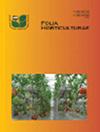Evaluation of the possibility of obtaining viable seeds from the cross-breeding Hippeastrum × chmielii Chm. with selected cultivars of Hippeastrum hybridum Hort.
IF 1.8
4区 农林科学
Q2 HORTICULTURE
引用次数: 2
Abstract
Abstract Hippeastrum sp. is a popular cut flower and a popular potted plant, currently occupying the 11th position among cut flowers sold on the Dutch flower auctions. Hippeastrum × chmielii was bred by Henryk Chmiel at the Warsaw University of Life Sciences (WULS), Poland. The aim of this study was designed to test the ability of two clones of H. × chmielii to reproduce generatively by pollinating by three cultivars of Hippeastrum hybridum – ‘Gervase’, ‘Rio Negro’ and ‘Royal Velvet’. Pollen viability was tested by germination on the medium and by acetocarmine staining. The receptiveness of the stigmas and ovules of H. × chmielii and thus their ability to possibly accept compatible pollen were checked by staining with red alizarin. The viability of pollen grains of tested cultivars was estimated at 66.4–83.0% and their high ability to develop pollen tube was found. It was determined that the embryos of both H. × chmielii clones were fully receptive. A total of 72 crossings were performed in 6 combinations. Seeds collected about 1 month after pollination were germinated immediately after harvest either on moist tissue paper on Petri dishes or in jars with distilled water. After 28 days the percentage of germinated seeds ranged between 48.3% and 77.9%, for different crosses. In the case of seeds obtained from crossing H. × chmielii clone 18 × H. hybridum ‘Gervase’ a higher average percentage of germinated seeds was obtained in jars while no differences were noted between the germination methods in other cases.杂交育种马尾草获得活种可能性的评价。与选定品种的海马菊短。
摘要海马菊(Hippeastrum)是一种受欢迎的切花和盆栽植物,目前在荷兰花卉拍卖的切花中排名第11位。chmielii是由Henryk Chmiel在波兰华沙生命科学大学(WULS)培育的。本研究旨在通过杂交马(Hippeastrum hybridum)的三个品种‘Gervase’、‘里约热内卢Negro’和‘Royal Velvet’的传粉,测试两个克隆的繁殖能力。通过培养基萌发和乙酰胭脂红染色检测花粉活力。用红茜素染色法测定了金针花柱头和胚珠的接受性,并由此测定了它们可能接受相容花粉的能力。试验品种花粉粒活力为66.4 ~ 83.0%,花粉管发育能力强。结果表明,两个克隆的胚胎均具有完全受感能力。共进行6种组合72次交叉。授粉后约1个月采集的种子在收获后立即在培养皿上的湿纸巾上发芽,或在装有蒸馏水的罐子里发芽。28 d后,不同杂交的种子发芽率在48.3% ~ 77.9%之间。在种子的情况下获得穿越h×chmielii克隆18×h . hybridum维斯的获得了更高的平均发芽种子的比例在罐子之间没有差异被发现在其他情况下的发芽方法。
本文章由计算机程序翻译,如有差异,请以英文原文为准。
求助全文
约1分钟内获得全文
求助全文
来源期刊

Folia Horticulturae
Agricultural and Biological Sciences-Horticulture
CiteScore
3.40
自引率
0.00%
发文量
13
审稿时长
16 weeks
期刊介绍:
Folia Horticulturae is an international, scientific journal published in English. It covers a broad research spectrum of aspects related to horticultural science that are of interest to a wide scientific community and have an impact on progress in both basic and applied research carried out with the use of horticultural crops and their products. The journal’s aim is to disseminate recent findings and serve as a forum for presenting views as well as for discussing important problems and prospects of modern horticulture, particularly in relation to sustainable production of high yield and quality of horticultural products, including their impact on human health.
 求助内容:
求助内容: 应助结果提醒方式:
应助结果提醒方式:


